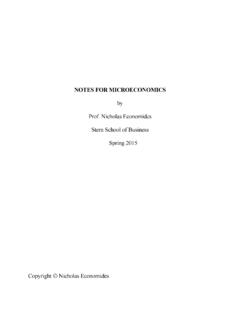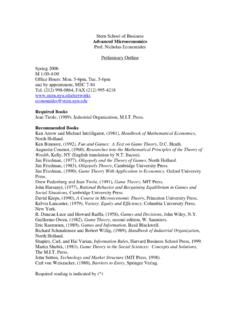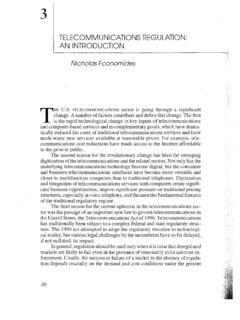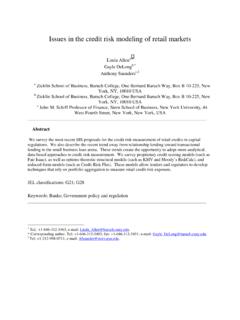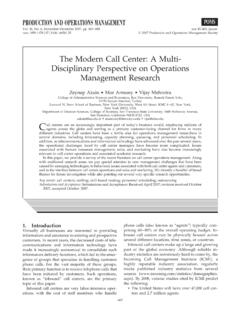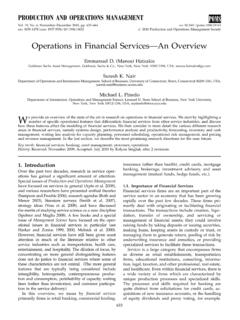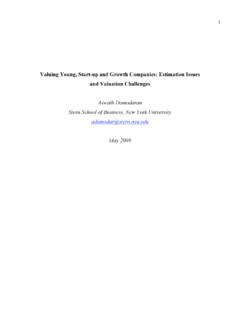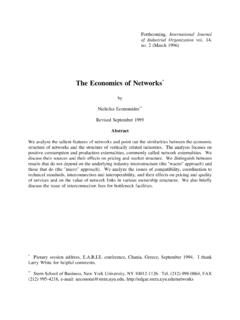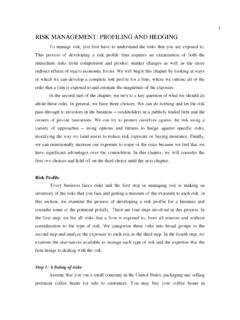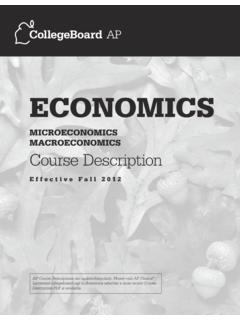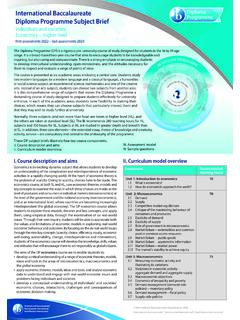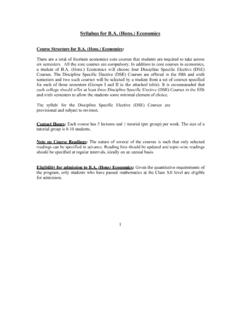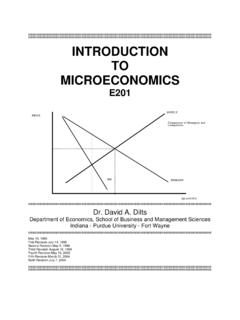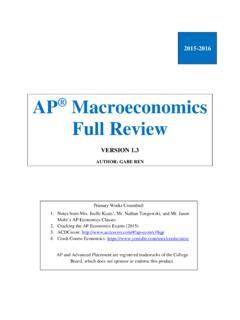Transcription of The Principles of Economics Textbook - New York University
1 The Principles of Economics Textbook : An Analysis of Its Past, Present & Future by Vitali Bourchtein An honors thesis submitted in partial fulfillment of the requirements for the degree of Bachelor of Science Undergraduate College Leonard N. Stern School of Business New York University May 2011 Professor Marti G. Subrahmanyam Professor Simon Bowmaker Faculty Advisor Thesis Advisor Bourchtein 1 Table of Contents Abstract ..4 Thank You ..4 Introduction ..5 Summary ..5 Part I: Literature Review ..6 David Colander What Economists Do and What Economists Teach ..6 David Colander The Art of Teaching Economics ..8 David Colander What We Taught and What We Did: The Evolution of US Economic Textbooks (1830-1930) ..10 Mark Skousen The Perseverance of Paul Samuelson s Economics .
2 12 Part II: Methodology Approach Taken and Books Used ..15 Approach Taken ..15 Books Used ..16 Part III: Analysis ..17 Textbook Size ..17 Consensus Text ..18 microeconomics ..19 Supply and Demand ..20 macroeconomics ..21 Aggregate Supply and Aggregate Demand ..22 Game Theory ..23 Behavioral Economics ..24 Labor Economics ..26 Economics of the Family ..27 Law and Economics ..28 Public Economics ..29 Health Economics ..30 Industrial Organization ..31 Environmental Economics ..32 Bourchtein 2 Urban Economics ..33 Race and Gender ..34 History of Economic Thought ..35 Money and Banking ..36 Fiscal Policy ..37 Economic Growth ..38 Development Economics ..39 International Trade ..40 Part IV: Concluding Thoughts and Future Outlook ..41 Summary of Findings ..41 The Future of Principles of Economics .
3 43 Exhibit A ..45 Exhibit B ..46 Exhibit C ..47 Exhibit D ..48 Exhibit E ..49 Exhibit Exhibit G ..51 Exhibit H ..52 Exhibit I ..53 Exhibit J ..54 Exhibit K ..55 Exhibit L ..56 Exhibit M ..57 Exhibit N ..58 Exhibit O ..59 Exhibit Exhibit Q ..61 Exhibit R ..62 Exhibit Bourchtein 3 Exhibit T ..64 Exhibit U ..65 Exhibit V ..66 Exhibit W ..67 Exhibit X ..68 Works Cited ..71 Bourchtein 4 Abstract Economics plays a large role in today s society, as it affects the majority of our decisions, as well as the decisions made by other individuals, corporations and governments. As a result, Economics is one of the most popular college majors. The study of Economics usually begins with a student taking a Principles of Economics course. The majority of the Principles classes use textbooks, which is why these books play a large role in Economics education.
4 This paper examines the past, present and future of the Principles of Economics textbooks. 12 different textbooks were analyzed and a consensus Textbook based on the amount of pages dedicated to 21 different topics was created. Following that, each of the 21 topics was further analyzed. The analysis included the maximum, minimum and average percentage of the Textbook allocated to each topic, as well as the description of subtopics that were covered or not covered under each of the chosen 21 topics. This thesis arrived at four main conclusions. First, over the past 20 years, the average size of the Principles of Economics Textbook decreased from 900+ to 757 pages. Second, the world is more global now than it was 20 years ago, yet there is actually less attention given to international trade in the textbooks.
5 Third, there is very little attention given to very important topics, such as behavioral Economics , development Economics , game theory, Economics of the family, and law and Economics . Fourth, the change in Principles of Economics textbooks has been very slow. _____ Thank You I would like to thank Professor Simon Bowmaker for his continuous support and guidance throughout the entire process of writing my thesis. I would also like to thank Professor Marti Subrahmanyam and Advisor Jessie Rosenzweig for organizing and facilitating such a wonderful program. Lastly, I would like to thank everyone in the 3rd floor leadership lounge for providing an amazing environment for working on this thesis. Bourchtein 5 Introduction Economics is a science that examines the production, distribution, and consumption of goods and services, as well as the creation of wealth.
6 The current studies of the Economics field can be traced back to the study of the political economy in the 19th century. As the study of mathematics developed, the study of Economics followed. The empirical approach has shaped today s Economics and has helped to develop current economic models. Studying Economics provides many valuable benefits, such as the knowledge that is needed to understand the impact of developments in business, society and the world economy. The study of Economics aids individuals in understanding the decisions of households, businesses and governments based on beliefs, human behavior, structure, needs and constraints. It also provides one with many opportunities and benefits besides simply understanding the finance industry; it teaches us about choice, opportunity, scarcity and the impact of decision making on society.
7 Principles of microeconomics and macroeconomics classes are taken by many students in thousands of different universities and colleges around the United States and the world. Students learn many practical theories in these classes, like how to use their money when buying new things by understanding the concepts of supply and demand. Since Economics plays such a large role in the daily life of Americans, it is important to understand how it is taught to the younger generations. Summary This thesis is going to analyze the content of Principles of Economics classes with a focus on textbooks by performing a content examination of 12 Principles of Economics textbooks and evaluating the page allocation given to different topics. From this point, the thesis will be structured as follows: Bourchtein 6 a) Part I: literature review of Principles of Economics textbooks, which will include writings on the way Economics is currently taught, as well as an analysis of the history of Principles of Economics textbooks b) Part II: a description of the methodology used and the approach taken in writing this thesis, as well as an introduction of the twelve textbooks that were used c) Part III: an analysis of the research d) Part IV.
8 Concluding thoughts and analysis of the future of Principles of Economics textbooks Part I Literature Review David Colander What Economists Do and What Economists Teach In this article, David Colander discusses the differences that exist today between what economists do in their day-to-day work and what they teach to their students. At one point in time, what economists did and taught were the same. However, the profession and the textbooks have evolved very differently. The changes in the work that economists do can be attributed to technological advances. These technological advances have made computers a crucial part of research and have made the research itself a lot more technical. These changes came with the understanding that the economy is a very complex system, and that a lot of the research is no longer possible without technology.
9 However, what economists teach has not evolved the same way. Most Economics lectures are a lot closer to story-telling than to mathematics. The teaching of Economics has been very slow in adopting the technological advances in research into the curriculum. The current structure of Principles of Economics textbooks reflects Samuelson s Bourchtein 7 Textbook from 1948, which was written before mathematics began to play as big of a role in research as it does today. However, Colander writes that increasing mathematics in Principles of Economics textbooks is not the solution to the problem, as only 1% of Principles students go on to economic research. microeconomics today focuses on what Colander calls the efficiency theory the books discuss in detail how rational individuals make decisions and how results that are beneficial for the common good arise from rational individuals actions channeled by the markets.
10 Principles classes and textbooks tend to focus on scarcity and constrained optimization. On the macroeconomics side, the focus is also on efficiency and on the idea that restrictions limit efficiency. Colander says that such an approach is good for entry level classes but that it has limitations, and these theories are expanded upon in higher level Economics courses. Samuelson wrote his first Textbook more than 60 years ago. At the time that it was written, his microeconomic explanations were along the lines of what all cutting-edge economists thought. Today, what economists think has changed drastically, but the textbooks have not followed. Colander believes that eventually textbooks will reflect the changes in economists thinking, but at this point there is too much capital tied up for these changes to occur rapidly.
